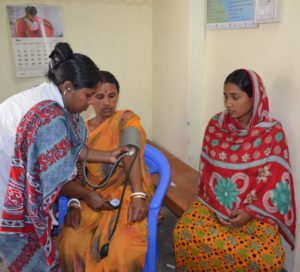 The primary objective of service communication is to compel the intended audience to act– to publicly support an available service, to talk to their partners and friends about the benefits of a service or health intervention, to adopt or maintain a behavior, to provide high-quality counseling, or to visit a clinic. In most cases, just sharing information is not enough to get people to go for services. This is why it is so important to understand why people act the way they do. Identifying those determinants needs to happen before designing your strategy and your communication activities or materials.
The primary objective of service communication is to compel the intended audience to act– to publicly support an available service, to talk to their partners and friends about the benefits of a service or health intervention, to adopt or maintain a behavior, to provide high-quality counseling, or to visit a clinic. In most cases, just sharing information is not enough to get people to go for services. This is why it is so important to understand why people act the way they do. Identifying those determinants needs to happen before designing your strategy and your communication activities or materials.
Why Is Understanding Behavioral Determinants Important to Service Communication?
There are many theories about the underlying reasons why people do or do not adopt behaviors. One of the most fundamental principles of SBCC is to reduce these barriers, as a means of facilitating change. Effective service communication first seeks to understand the full range of reasons why an audience is unwilling to adopt or maintain a behavior, and/or their motivators, before developing communication strategies and messages. Failing to do so before program design can lead to inappropriate communication objectives, poor allocation of resources, ineffective programs, and limited impact on behavioral outcomes.
More information on the key behavioral theory used in SBCC: Popular Behavioral Theory
What Are Determinants of Behavior Change?
An individual’s ability and willingness to adopt and maintain positive behaviors is often affected by a number of factors that make it easy or difficult to change. Knowledge and awareness of a health problem or service are rarely the only reasons why individuals act or adopt positive behaviors. For example, simply knowing that family planning services or HIV tests are available and where to find services is typically not enough to motivate the intended audience to visit or to make long-term changes in their behavior. Individuals have a number of reasons for adopting or resisting behavior change. These barriers or facilitators are called behavioral “determinants.”
In addition to individual determinants, relationships and communities can influence someone’s willingness and capacity to get health services. Barriers can result from deliberate blocking of access to services or from a general perception that services are inappropriate or wrong. Lastly, physical or logistical barriers and gender and cultural norms can prevent service uptake.
In Guinea, HC3 sought to rebuild confidence in health services after the Ebola epidemic. To do so, they needed to understand why people were not accessing services. They started a community dialogue intervention (assise communuautaire) where health providers and community representatives meet to discuss reasons why people do not use health services. Community members cited unfriendly providers, high medication costs, incompetent staff, dirty health centers, and lack of motivation. At the end of the dialogues, both groups commit to specific actions they will take to improve relationships. Based on their understanding of key behavioral determinants, the project developed IPC and training materials, radio to inform clients of their rights, songs, community outreach, and health education sessions.
Determinants can be categorized into three main groups related to the environment, skills and knowledge, and ideation.
Environmental:
- Availability of services
- Location of services – is the location that is preferred by clients
- A supportive legal and policy environment for the services
Skills and Knowledge:
- Level of awareness of the service and/or the resulting health benefit
- Level of awareness of the skills or steps required to access the service or maintain the behaviors
- Beliefs about the required skills or behavior: Are they considered too difficult? Does the intended audience believe they have the time to perform the necessary behaviors?
- Does the intended audience feel that they can’t do the behavior on their own? Do they need help to accomplish the behavior?
- Is the behavior something the audience can consistently remember to do, or do they often forget (for example, keeping a treatment journal, keeping appointments, taking a daily pill)?
Ideational:
- What are the prevailing beliefs about the behavior or intended audience? Are they positive or negative (for example, “men who have sex with men are immoral” or “adolescents should not use family planning”)?
- How much social support does the audience have to pursue services or maintain required behaviors?
- What are the prevailing social and gender norms about the service or health area? Are they supportive or unsupportive?
For more information on ideation, see the Ideation Primer.
Note: External Barriers and the Role of SBCC
Very often, the ability to effectively address a health problem and motivate change is linked to other types of barriers that communication cannot address on its own (for instance, policy barriers that render services unavailable, under-resourced, or criminalized). Although advocacy can help mobilize resources for new technologies and motivate support for more supportive policies, communication alone cannot change other problems that limit access, such as poor health systems, inadequate commodity supplies, and limited financing. Service delivery programs must carefully understand all external barriers to behavior change and then determine what role communication can play.
Identifying and selecting the most relevant determinants for any service delivery program requires programs to consider several questions:

